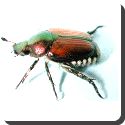 Japanese Beetle — The Japanese beetle is a beetle about 1.5 cm (0.6 inches) long and 1 cm (0.4 inches) wide (smaller in Canada), with shiny copper-colored elytra and a shiny green top of the thorax and head. It is not very destructive in Japan, where it is controlled by natural enemies, but in America it is a serious pest to rose bushes, grapes, canna, crape myrtles, and other plants. It is a weak flyer and drops several centimeters when it hits a wall. Japanese beetle traps therefore consist of a pair of crossed walls with a bag underneath, and are baited with floral scent, pheromone, or both. However, studies done at the University of Kentucky suggest that traps attract more beetles than they actually trap, thus causing more damage than may have occurred were the trap not used.
Japanese Beetle — The Japanese beetle is a beetle about 1.5 cm (0.6 inches) long and 1 cm (0.4 inches) wide (smaller in Canada), with shiny copper-colored elytra and a shiny green top of the thorax and head. It is not very destructive in Japan, where it is controlled by natural enemies, but in America it is a serious pest to rose bushes, grapes, canna, crape myrtles, and other plants. It is a weak flyer and drops several centimeters when it hits a wall. Japanese beetle traps therefore consist of a pair of crossed walls with a bag underneath, and are baited with floral scent, pheromone, or both. However, studies done at the University of Kentucky suggest that traps attract more beetles than they actually trap, thus causing more damage than may have occurred were the trap not used.
Japanese beetles have a curious, identifying defense: they lift their hind legs up in the air, even when simply approached. These hind legs are spiny, and the behavior is probably intended to ward off predators.
These insects damage plants by eating the surface material, leaving the veins in place, producing a curious, but alarming to the experienced gardener, “transparent leaf” effect on its victims.
The life cycle of the beetle is typically one year in most parts of the United States, but this can be extended in cooler climates; for instance, in its native Japan, the beetle’s life cycle is two years long as a result of the higher latitudes of the grasslands required for the larval stage.
During the larval stage, the Japanese beetle lives in lawns and other grasslands, where it eats the roots of grass. During that stage, it is susceptible to a fatal disease called milky spore disease, caused by a bacterium called milky spore, Bacillus popilliae. The USDA developed this biological control and it is commercially available in powder form for application to lawn areas. Standard applications (low density across a broad area) take from one to five years to establish maximal protection against larval survival (depending on climate), expanding through the soil through repeated rounds of infection, in-host multiplication, release from killed host, and infection. Typically proper application can lead to a 15-20 year period of protection.
 Kids Portal For Parents India Kids Network
Kids Portal For Parents India Kids Network
